#agricultural goods
Text
"Marginal improvements to agricultural soils around the world would store enough carbon to keep the world within 1.5C of global heating, new research suggests.
Farming techniques that improve long-term fertility and yields can also help to store more carbon in soils but are often ignored in favor of intensive techniques using large amounts of artificial fertilizer, much of it wasted, that can increase greenhouse gas emissions.
Using better farming techniques to store 1 percent more carbon in about half of the world’s agricultural soils would be enough to absorb about 31 gigatons of carbon dioxide a year, according to new data. That amount is not far off the 32 gigaton gap between current planned emissions reduction globally per year and the amount of carbon that must be cut by 2030 to stay within 1.5C.
The estimates were carried out by Jacqueline McGlade, the former chief scientist at the UN environment program and former executive director of the European Environment Agency. She found that storing more carbon in the top 30 centimeters of agricultural soils would be feasible in many regions where soils are currently degraded.
McGlade now leads a commercial organization that sells soil data to farmers. Downforce Technologies uses publicly available global data, satellite images, and lidar to assess in detail how much carbon is stored in soils, which can now be done down to the level of individual fields.
“Outside the farming sector, people do not understand how important soils are to the climate,” said McGlade. “Changing farming could make soils carbon negative, making them absorb carbon, and reducing the cost of farming.”
She said farmers could face a short-term cost while they changed their methods, away from the overuse of artificial fertilizer, but after a transition period of two to three years their yields would improve and their soils would be much healthier...
Arable farmers could sequester more carbon within their soils by changing their crop rotation, planting cover crops such as clover, or using direct drilling, which allows crops to be planted without the need for ploughing. Livestock farmers could improve their soils by growing more native grasses.
Hedgerows also help to sequester carbon in the soil, because they have large underground networks of mycorrhizal fungi and microbes that can extend meters into the field. Farmers have spent decades removing hedgerows to make intensive farming easier, but restoring them, and maintaining existing hedgerows, would improve biodiversity, reduce the erosion of topsoil, and help to stop harmful agricultural runoff, which is a key polluter of rivers."
-via The Grist, July 8, 2023
#agriculture#sustainable agriculture#sustainability#carbon emissions#carbon sequestration#livestock#farming#regenerative farming#native plants#ecosystems#global warming#climate change#good news#hope
4K notes
·
View notes
Text

Source

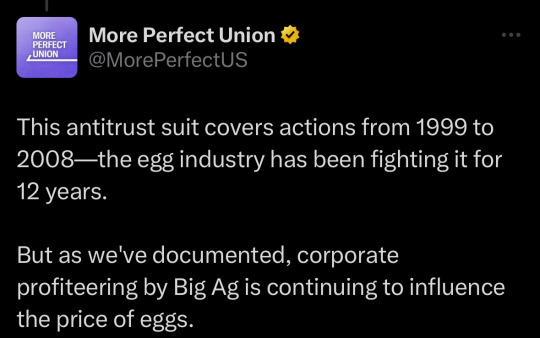


Source
1K notes
·
View notes
Text
what do you mean 44% of American Corn goes to fuel ethanol. Barbaric. What the hell.

Agricultural policy... is not very good! And I know that already but it's somehow even more ridiculous than my intuition. Basically all increases in corn production since 1980 have gone into fuel ethanol. Just don't use that land! It's free carbon sequestration!
#i refuse to use the word biofuel it makes people think it's good#ecology#agriculture#realized i wasn't subscribed to Hannah Richie's substack the other day
849 notes
·
View notes
Text
concept: throughout history vampires have infiltrated royal courts & higher places of learning in the guise of medical practitioners, simply and solely for the purpose of keeping bloodletting in fashion
#another good vampire post#and for 3000 years it WORKED#from the vampires' pov this is no different than the human invention of agriculture#or possibly animal husbandry#*shrugs* domestication is just more convenient than hunting & gathering
6K notes
·
View notes
Text
Brazil’s supreme court has blocked efforts to dramatically strip back Indigenous land rights in what activists called a historic victory for the South American country’s original inhabitants.

Indigenous people celebrate the ruling in Brasilia. Photograph: Gustavo Moreno/AP
[…] Similar scenes played out across the Amazon region, which is home to about half of Brazil’s 1.7 million Indigenous citizens.
“[This is a] victory for struggle, a victory for rights, a victory for our history,” the Indigenous congresswoman Célia Xakriabá tweeted. “[All of] Brazil is Indigenous territory and the future is ancestral.”
[…] Casting her vote against a thesis a majority of justices decided was unconstitutional, judge Cármen Lúcia Antunes Rocha said: “We are caring for the ethnic dignity of a people who have been decimated and oppressed during five centuries of history.”
Brazilian society had “an unpayable debt” to the country’s native peoples, Rocha said.
The Indigenous rights group Survival International commemorated the defeat of what it called an attempt “to legalize the theft of huge areas of Indigenous lands”. Dozens of uncontacted tribes could have been wiped out had such efforts prospered, the group claimed.
Source: the guardian
#an anon asked me about this a few months ago#and maybe some of you want good news today#protecting indigenous people protects the Amazon from deforestation by the agricultural sector that proposed this change to strip the land#from the indigenous groups who actually own it
278 notes
·
View notes
Text
Millions of U.S. apples were almost left to rot. Now, they'll go to hungry families
NOVEMBER 27, 2023 By Alan Jinich
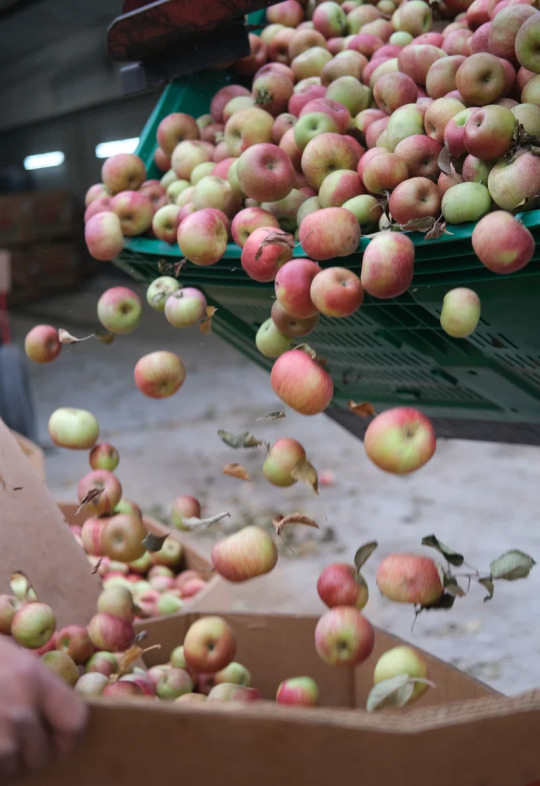
It's getting late in the harvest season in Berkeley County, West Virginia and Carla Kitchen's team is in the process of hand-picking nearly half a million pounds of apples. In a normal year, Kitchen would sell to processors like Andros that make applesauce, concentrate, and other products. But this year they turned her away.
...
Across the country, growers were left without a market. Due to an oversupply carried over from last year's harvest, growers were faced with a game-time economic decision: Should they pay the labor to harvest, crossing their fingers for a buyer to come along, or simply leave the apples to rot?

Bumper crops, export declines and the weather have contributed to the apple crisis
...
While many growers in neighboring states like Maryland and Virginia left their apples to drop. Sen. Joe Manchin of West Virginia was able to convince the United States Department of Agriculture (USDA) to pay for the apples produced by growers in his state, which only makes up 1% of the national market.
A relief program in West Virginia donated its surplus apples to hunger-fighting charities
This apple relief program, covered under Section 32 of the Agricultural Adjustment Act of 1935, purchased $10 million worth of apples from a dozen West Virginia growers. Those apples were then donated to hunger-fighting charities across the country from South Carolina and Michigan all the way out to The Navajo Nation.
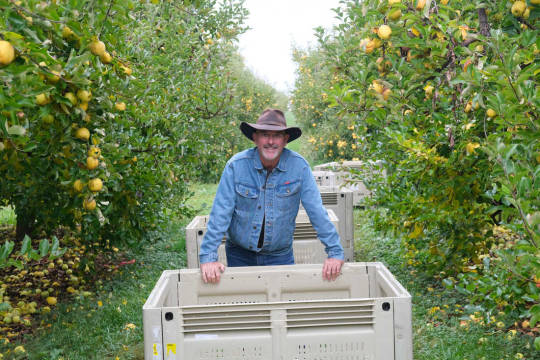
Mike Meyer, head of advocacy at The Farmlink Project, says it's the largest food rescue they've ever done and they hope it can serve as a model for their future missions.
"There's over 100 billion pounds of produce waste in this country every year; we only need seven billion to drive food insecurity to zero," Meyer says. "We're very happy to have this opportunity. We get to support farmers, we get to fight hunger with an apple. It's one of the most nutritional items we can get into the hands of the food insecure."
At Timber Ridge Fruit Farm in Virginia, owners Cordell and Kim Watt watch a truck from The Farmlink Project load up on their apples before driving out to a food pantry in Bethesda, Md. Despite being headquartered in Virginia, Timber Ridge was able to participate in the apple rescue since they own orchards in West Virginia as well. Cordell is a third-generation grower here and he says they've never had to deal with a surplus this large.
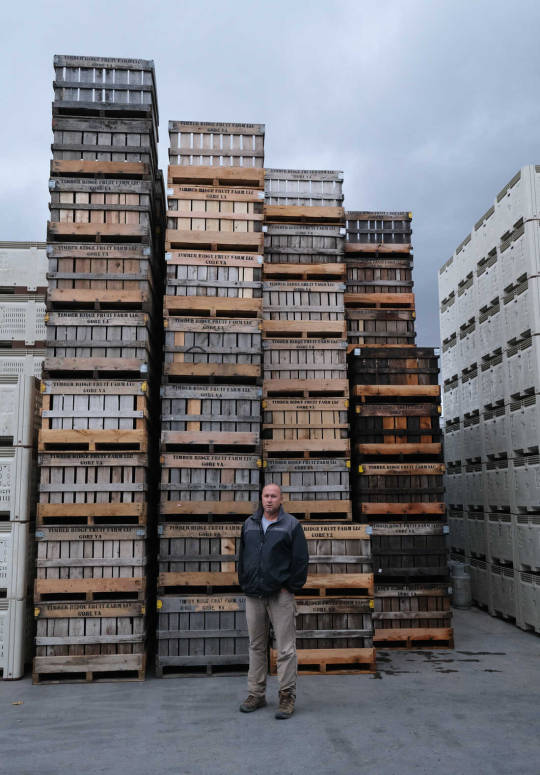
At the So What Else food pantry in Bethesda, Md., apple pallets from Timber Ridge fill the warehouse up to the ceiling. Emanuel Ibanez and other volunteers are picking through the crates, bagging fresh apples into family-sized loads.
"I'm just bewildered," Ibanez says. "We have a warehouse full of apples and I can barely walk through it."
"People in need got nutritious food out of this program. And that's the most important thing"
Executive director Megan Joe says this is the largest shipment of produce they've ever distributed – 10 truckloads over the span of three weeks. The food pantry typically serves 6,000 families, but this shipment has reached a much wider circle.
"My coworkers are like, 'Megan, do we really need this many?' And I'm like, yes!" Joe says. "The growing prices in the grocery stores are really tough for a lot of families. And it's honestly gotten worse since COVID."

"It's the first time we've done this type of program, but we believe it can set the stage for the region," Kent Leonhardt, West Virginia's commissioner of agriculture says. "People in need got nutritious food out of this program. And that's the most important thing."
Following West Virginia's rescue program, the USDA announced an additional $100 million purchase to relieve the apple surplus in other states around the country. This is the largest government buy of apples and apple products to date. But with the harvest window coming to an end, many growers have already left their apples to drop and rot.
191 notes
·
View notes
Text
why does the pjo series have to unnecessarily villainize goddesses (hera & athena) or show them as silly ladies (aphrodite & demeter) BUT posiedon and apollo are somehow shown as the coolest/most likeable gods, even though arguably, they're right after zeus on terms of corruption?
ares shown as the worst god after zeus and hera amuses me. last time i checked, he was the patron god of amazons and literally killed a man for attempting to rape his daughter but guess who cursed women for rejection? apollo. guess who raped women when they said no (aside from zeus)? posiedon.
#all the gods and goddesses in the greek mythology are flawed in their own way#it doesn't make sense why the books were so unnecessarily biased towards certain gods?#it bothers me specifically that hera and athena are SO unnecessarily painted as villains#while posiedon is ‘cool’ dad ‘great’ lover ‘decent’ god ‘reasonable’ than other olympians#i get it he's the main character's father of a children's fantasy novel so rick painted him in a good light#but my man? then why are you painting other gods who are arguably just as bad as him as WORSE#shut up i feel strongly about it#i love the percy jackson series#but i hate how the gods are portrayed#is trials of apollo a good series? yes#does it make sense why he's shown as a human-like god with redemption arc#while hera is reduced to ‘evil stepmom’ and ‘bitch to annabeth’ even if apollo is JUST as bad as her?#no#and aphrodite is not some ‘silly fangirl’ whose personality revolves around shipping percabeth#she is powerful terrifying and cunning who can bestow some of worst revenge on those who offend her#demeter is not a silly crop goddess#her love for her daughter was so strong it almost ended the world and destroyed mankind#shes in charge of harvest and agriculture without her humanity will starve to death#shes just as powerful as the big-3 or at least she should be#posiedon is not this cool perfect rational god#medusa would disagree demeter would disagree pasiphae would disagree odysseus would disagree#apollo cursed women posiedon raped yet ares killed a rapist BUT nooo let's make ares the bad one#percy jackson#rr crit#greek mythology#heroes of olympus#trials of apollo
55 notes
·
View notes
Text
one thing thats so interesting about being a vegetarian is you get to hear all about everyones hypothetical activism that they care about very deeply when talking specifically about your diet and why it's stupid, but literally will never bring up ever again in any other context
#good idea generator#ppl will honest to god hit me with a 'well what about the dmg caused by plant agriculture' when i say im vegetarian for the environment#oh please tell me more about all the things youre doing to try to minimize your impact on the environment#and all the things you know about agriculture. in your infinite wisdom of [checks notes] doing the exact same thing you always have#or is the argument that because individual choices make little difference that we shouldnt even try or talk about it in case its annoying?#its not necessarily that these people arent making good points also#its just that when you have these same conversations 75 times over and over and over and OVER and get nowhere#it starts to become obvious most people learn these arguments in order to avoid genuinely interrogating their eating practices#either on an individual or communal level. am not asking you to cut out meat or go vegan (not a realistic demand of everyone on earth)#but i AM asking that you please do some self reflection on why the idea makes you so defensive#and about what exactly is so terrible of the idea that we may need to produce and consume less meat#i thought about 75 disclaimers i could put on this post but honestly if they become necessary it would prove my point
110 notes
·
View notes
Text
In response to last year’s record-breaking heat due to El Niño and impacts from climate change, Indigenous Zenù farmers in Colombia are trying to revive the cultivation of traditional climate-resilient seeds and agroecology systems.
One traditional farming system combines farming with fishing: locals fish during the rainy season when water levels are high, and farm during the dry season on the fertile soils left by the receding water.
Locals and ecologists say conflicts over land with surrounding plantation owners, cattle ranchers and mines are also worsening the impacts of the climate crisis.
To protect their land, the Zenù reserve, which is today surrounded by monoculture plantations, was in 2005 declared the first Colombian territory free from GMOs.
#good news#science#environmentalism#indigenous people#indigenous agriculture#zenù#agroecology#nature#environment#farming#sustainable farming#climate resilience#climate change#columbia
55 notes
·
View notes
Text
I feel like there is a strong correlation to Frank Hubert’s initial subtext with Dune (its islamic religious themes, a premise setting an empire against local populaces, the attention towards ecological developments in desert environments with a bias towards temperate zones from outsiders wanting to “enrich” the land), and all of the recent developments in Gaza and its history, both with the original influences to Hubert’s novel and the timing of a blockbuster adaptation happening while international focus grows towards Palestine, that is going unmentioned outside of the usual jokes and memes
#dune#palestine#gaza#free gaza#science fiction#media#Like yes the popcorn bucket is dumb and tone deaf marketing#but like you have a lot of connections#lot of it was very much allegorical to the real like events that took place during the time of the books conception#Including the good guy faction still imposing their own idea of correct environment by introducing a bunch of their own agriculture#When natives to the region do have their own tech and plants to live from#because they know their land and how to live in it#Oh and also spice being a resource being plundered for great profit that a imperial society is reliant on and will kill for
53 notes
·
View notes
Note
Idea: orchard harvester saddle. More of a standing platform with a scooter handlebar for the rider where the centaur can hand things up and down. (playing Farming Simulator is making me crave more peaceful/agricultural world building; there's already so much Warlike WB around, it needs some balance)
(also, eat like a horse vs eat like a bird, horse metab is high efficiency but a lot of it just due to net size, imagine that efficiency applied to refined grains and breads. Centaur diets would be less-per-weight than humans, although not necessarily by much due to the metabolic needs of sapient brain and foretorso)
Ohhhh I absolutely love this and absolutely think it should be a thing. I've been thinking more about the inherent benefits of centaurs in an agrarian society and more and more the borders of the Merchant city has been expanding outward towards the edge of Rider territory with enormous matriarchal farm towns that feed most of the surrounding societies so this would fit right in to that kind of lifestyle! And sounds so useful! One doing the moving and loadbearing, one doing the climbing and picking.
And I agree, war shapes societies undeniably but so many worldbuilders forget that trade, craft and industry shape cultures and societies just as much! It's definitely a topic i could GO OFF about haha, I have major exports and interrelated trade agreements drawn up between ALL my current societies 😁
(also absolutely, the use of refined grains and bread was a huge part of my initial thoughts about how centaurs could survive feeding that big horse body with comparatively small/limited human teeth. The efficiency of processed grain and grass fibers would be SO necessary to their digestion and overall survival!)
#asked and answered#centaurs#agricultural pursuits#i have DESIGNS#for the rural merchant centaurs#it started with designing their homes#and then turned into a whole matriarchal time share family system#completely unique from the city centaurs#of the merchant culture#also good food thoughts#feeding that high energy brain#AND#that big horse body#would still require a lot of food#but the magic of human intervention#is the power of processed foods#and the beautiful glut of calories they provide
47 notes
·
View notes
Text
"In response to last year’s record-breaking heat due to El Niño and impacts from climate change, Indigenous Zenù farmers in Colombia are trying to revive the cultivation of traditional climate-resilient seeds and agroecology systems.
One traditional farming system combines farming with fishing: locals fish during the rainy season when water levels are high, and farm during the dry season on the fertile soils left by the receding water.
Locals and ecologists say conflicts over land with surrounding plantation owners, cattle ranchers and mines are also worsening the impacts of the climate crisis.
To protect their land, the Zenù reserve, which is today surrounded by monoculture plantations, was in 2005 declared the first Colombian territory free from GMOs.
...
In the Zenù reserve, issues with the weather, climate or soil are spread by word of mouth between farmers, or on La Positiva 103.0, a community agroecology radio station. And what’s been on every farmer’s mind is last year’s record-breaking heat and droughts. Both of these were charged by the twin impacts of climate change and a newly developing El Niño, a naturally occurring warmer period that last occurred here in 2016, say climate scientists.
Experts from Colombia’s Institute of Hydrology, Meteorology and Environmental Studies say the impacts of El Niño will be felt in Colombia until April 2024, adding to farmers’ concerns. Other scientists forecast June to August may be even hotter than 2023, and the next five years could be the hottest on record. On Jan. 24, President Gustavo Petro said he will declare wildfires a natural disaster, following an increase in forest fires that scientists attribute to the effects of El Niño.
In the face of these changes, Zenù farmers are trying to revive traditional agricultural practices like ancestral seed conservation and a unique agroecology system.
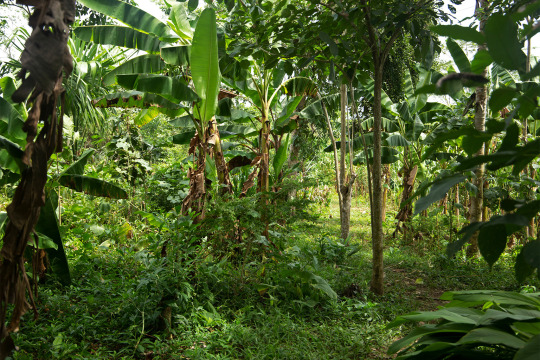
Pictured: Remberto Gil’s house is surrounded by an agroforestry system where turkeys and other animals graze under fruit trees such as maracuyá (Passiflora edulis), papaya (Carica papaya) and banana (Musa acuminata colla). Medicinal herbs like toronjil (Melissa officinalis) and tres bolas (Leonotis nepetifolia), and bushes like ají (Capsicum baccatum), yam and frijol diablito (beans) are part of the undergrowth. Image by Monica Pelliccia for Mongabay.
“Climate change is scary due to the possibility of food scarcity,” says Rodrigo Hernandez, a local authority with the Santa Isabel community. “Our ancestral seeds offer a solution as more resistant to climate change.”
Based on their experience, farmers say their ancestral seed varieties are more resistant to high temperatures compared to the imported varieties and cultivars they currently use. These ancestral varieties have adapted to the region’s ecosystem and require less water, they tell Mongabay. According to a report by local organization Grupo Semillas and development foundation SWISSAID, indigenous corn varieties like blaquito are more resistant to the heat, cariaco tolerates drought easily, and negrito is very resistant to high temperatures.
The Zenù diet still incorporates the traditional diversity of seeds, plant varieties and animals they consume, though they too are threatened by climate change: from fish recipes made from bocachico (Prochilodus magdalenae), and reptiles like the babilla or spectacled caiman (Caiman crocodilus), to different corn varieties to prepare arepas (cornmeal cakes), liquor, cheeses and soups.
“The most important challenge we have now is to save ancient species and involve new generations in ancestral practice,” says Sonia Rocha Marquez, a professor of social sciences at Sinù University in the city of Montería.
...[Despite] land scarcity, Negrete says communities are developing important projects to protect their traditional food systems. Farmers and seed custodians, like Gil, are working with the Association of Organic Agriculture and Livestock Producers (ASPROAL) and their Communitarian Seed House (Casa Comunitaria de Semillas Criollas y Nativas)...
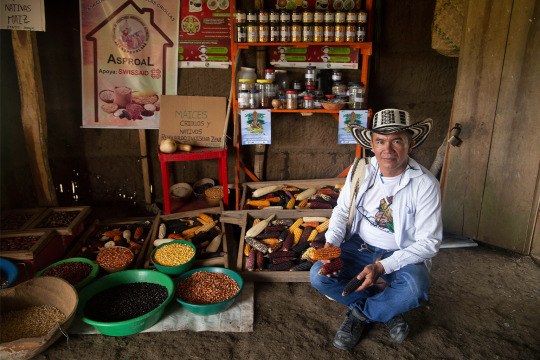
Pictured: Remberto Gil is a seed guardian and farmer who works at the Communitarian Seed House, where the ASPROL association stores 32 seeds of rare or almost extinct species. Image by Monica Pelliccia for Mongabay.
Located near Gil’s house, the seed bank hosts a rainbow of 12 corn varieties, from glistening black to blue to light pink to purple and even white. There are also jars of seeds for local varieties of beans, eggplants, pumpkins and aromatic herbs, some stored in refrigerators. All are ancient varieties shared between local families.
Outside the seed bank is a terrace where chickens and turkeys graze under an agroforestry system for farmers to emulate: local varieties of passion fruit, papaya and banana trees grow above bushes of ají peppers and beans. Traditional medicinal herbs like toronjil or lemon balm (Melissa officinalis) form part of the undergrowth.
Today, 25 families are involved in sharing, storing and commercializing the seeds of 32 rare or almost-extinct varieties.
“When I was a kid, my father brought me to the farm to participate in recovering the land,” says Nilvadys Arrieta, 56, a farmer member of ASPROAL. “Now, I still act with the same collective thinking that moves what we are doing.”
“Working together helps us to save, share more seeds, and sell at fair price [while] avoiding intermediaries and increasing families’ incomes,” Gil says. “Last year, we sold 8 million seeds to organic restaurants in Bogotà and Medellín.”
So far, the 80% of the farmers families living in the Zenù reserve participate in both the agroecology and seed revival projects, he adds."
-via Mongabay, February 6, 2024
#indigenous#ecology#agroforestry#agriculture#traditional food systems#traditional medicine#sustainable agriculture#zenu#indigenous peoples#farming#colombia#indigenous land#traditional knowledge#seeds#corn#sustainability#botany#plant biology#good news#hope#climate action#climate change#climate resilience#agroecology#food sovereignty
1K notes
·
View notes
Note
weird question, but do you know if regenerative agriculture is growing, and by what rate? it's important to me but looking for articles on my own can trigger a panic attack :[ no worries if not !
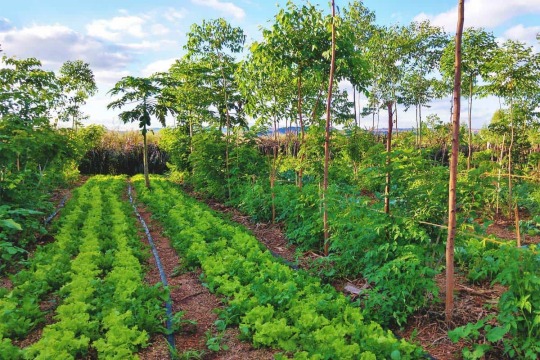
Hey! Thank you so much for asking. Honestly, agriculture and sustainable agriculture specifically are very close to my heart as well, so I was glad for the excuse to do some research :)
Also, thank you for your patience, I know you sent this Ask a bit ago. It’s good that you’re listening to yourself and not going around searching for things that might cause you harm, so thanks again for reaching out!
So, what is regenerative agriculture?
Regenerative agriculture is a way of farming that focuses on soil health. When soil is healthy, it produces more food and nutrition, stores more carbon and increases biodiversity – the variety of species. Healthy soil supports other water, land and air environments and ecosystems through natural processes including water drainage and pollination – the fertilization of plants.
Regenerative agriculture is a defining term for sustainability in our food system - while there is no one true definition of regenerative agriculture, the concept has been around for centuries, taking root in Indigenous growing practices. Regenerative approaches can bolster soil health and watershed health. They can also add to climate mitigation and potentially tie into regulatory or commercial incentives for a more sustainable diet.
Regenerative farming methods include minimizing the ploughing of land. This keeps CO2 in the soil, improves its water absorbency and leaves vital fungal communities in the earth undisturbed.
Rotating crops to vary the types of crop planted improves biodiversity, while using animal manure and compost helps to return nutrients to the soil.
Continuously grazing animals on the same piece of land can also degrade soil, explains the Regenerative agriculture in Europe report from the European Academies’ Science Advisory Council. So regenerative agriculture methods include moving grazing animals to different pastures.
How can it help?
Regenerative farming can improve crop yields – the volume of crops produced – by improving the health of soil and its ability to retain water, as well as reducing soil erosion. If regenerative farming was implemented in Africa, crop yields could rise 13% by 2040 and up to 40% in the future, according to a Regenerative Farming in Africa report by conservation organization the International Union for Conservation of Nature and the UN.
Regenerative farming can also reduce emissions from agriculture and turn the croplands and pastures, which cover up to 40% of Earth’s ice-free land area, into carbon sinks. These are environments that naturally absorb CO2 from the atmosphere, according to climate solutions organization Project Drawdown.
5 ways to scale regenerative agriculture:
1. Agree on common metrics for environmental outcomes. Today, there are many disparate efforts to define and measure environmental outcomes. We must move to a set of metrics adopted by the whole food industry, making it easier for farmers to adjust their practices and for positive changes to be rewarded.
2. Build farmers’ income from environmental outcomes such as carbon reduction and removal. We need a well-functioning market with a credible system of payments for environmental outcomes, trusted by buyers and sellers, that creates a new, durable, income stream for farmers.
3. Create mechanisms to share the cost of transition with farmers. Today, all the risk and cost sits with the farmers.
4. Ensure government policy enables and rewards farmers for transition. Too many government policies are in fact supporting the status quo of farming. The food sector must come together and work jointly with regulators to address this.
5. Develop new sourcing models to spread the cost of transition. We must move from sourcing models that take crops from anywhere to models that involve collaboration between off-takers from different sectors to take crops from areas converting to regenerative farming.
The rise of regenerative agriculture
In 2019, General Mills, the manufacturer of Cheerios, Yoplait and Annie’s Mac and Cheese (among other products), announced it would begin sourcing a portion of its corn, wheat, dairy and sugar from farmers who were engaged in regenerative agriculture practices and committed to advancing the practice of regenerative agriculture on one million acres of land by 2030. In early 2020, Whole Foods announced regenerative agriculture would be the No. 1 food trend and, in spite of the pandemic and the rapid growth of online shopping overshadowing the trend, business interest in the field still spiked by 138%.
More recently, PepsiCo announced it was adopting regenerative agriculture practices among 7 million acres of its farmland. Cargill declared it intends to do the same on 10 million acres by 2030, and Walmart has committed to advancing the practice on 50 million acres. Other companies pursuing regenerative agriculture include Danone, Unilever, Hormel, Target and Land O’ Lakes.
According to Nielsen, 75% of millennials are altering their buying habits with the environment in mind. This sentiment, of course, does not always materialize into tangible actions on behalf of every consumer. However, it is clear from the actions of PepsiCo, General Mills, Walmart, Unilever and others that they believe consumers’ expectations of what is environmentally friendly are shifting and that they will soon be looking to purchase regeneratively-produced foods because of the many benefits they produce.
The next step in the transition to regenerative agriculture is certification. The goal is to create labeling that will allow the consumer to connect to the full suite of their values. Some companies are partnering with nonprofit conveners and certifiers. The Savory Institute is one such partner, convening producers and brands around regenerative agriculture and more holistic land management practices.
In 2020, the Savory Institute granted its first “Ecological OutCome Verification (EOV) seal to Epic’s latest high protein bars by certifying that its featured beef was raised with regenerative agriculture practices.
The program was developed to let the land speak for itself by showing improvement through both leading and lagging functions such as plant diversity and water holding capacity. There are now thousands of products that have been Land to Market verified, with over 80 brand partnerships with companies such as Epic Provisions, Eileen Fisher and Applegate. Daily Harvest is giving growers in that space three-year contracts as well as markets and price premiums for the transitional crop. It's focusing on that transitional organic process as a stepping stone toward a regenerative organic food system.
Daily Harvest’s Almond Project creates an alliance with the Savory Institute and a group of stakeholders - including Simple Mills and Cappello’s - to bring regenerative practices to almonds in the Central Valley of California.
These companies are working with Treehouse California Almonds, their shared almond supplier, to lead soil health research on 160 acres of farmland. Over five years, the Project will focus on measuring outcomes around the ecosystem and soil health of regenerative practices – comparing those side by side with neighboring conventional baselines.
“We need industry partnership; we need pre-competitive collaboration,” says Rebecca Gildiner, Director of Sustainability at Daily Harvest, of the Almond Project. “Sustainability cannot be competitive. We are all sharing suppliers, we are all sharing supply – rising tides truly lift all boats. The industry has to understand our responsibility in investing, where historically investments have disproportionately focused on yields with a sole focus of feeding the world. We know this has been critical in the past but it has overlooked other forms of capital, other than financial. We need to look towards experimenting in holistic systems that have other outcomes than yield and profit - instead of saying organic can’t feed the world, we have to invest in figuring out how organic can feed the world because it’s critical.”
////
In short!!!
Many articles are stating regenerative agriculture as a defining, and rising “buzz word” in the industry. It seems that consumers are becoming more and more aware and are demanding more sustainable approaches to agriculture.
We, of course, have a way to go, but it seems from the data that I’ve gathered, that regenerative agriculture is, in fact, on the rise. Demand is rising, and many are working on ways to globalize those methods.
Source Source Source Source
#climate change#climate#hope#good news#climate news#climate crisis#more to come#climate emergency#news#climate justice#agriculture#ecosystem#farming#conservation#biodiversity#regenerative agriculture
81 notes
·
View notes
Text
i came out of s2 loving sydrichie even more 😭 the tension between them was perfect and now they’ll have a new dynamic to continue to discover ever since richie’s character growth. very exciting!!
#they may not have had a lot of scenes but i think this season was to develop him and maybe s3 will be theirs fingers crossed#there is still hope for us!!!!!! (i am a hopeful idiot btw)#thank u for the art ayo and ebon#sydrichie#sydney x richie#richie x sydney#the bear spoilers#their first s2 scene together made me almost lose it#also the last ep when she goes to him real up close and her voice cracks i can't stop rewatching that whole sequence#and they work together!!! and everything goes great!#wAIT AND THE SCENE WHERE SHE TELLS HIM HE SMELLS GOOD ?¿????¿ GIRL..#otp: the goddess of agriculture
84 notes
·
View notes
Link
“How do you supercharge vegetation growth for a reforestation project? Bring in the microorganisms.
That’s the finding from a new study, which shows that incorporating a microbial community of fungi, bacteria, algae and archaea into ecosystem restoration can accelerate plant biomass production by 64% on average.
Researchers say this application holds plenty of promise for restoration work in Southeast Asia, where large swaths of once-forested landscapes have been degraded for large-scale agriculture.
Soil microbiome like fungi carry out a critical task known as soil transplant, moving soil and associated microbial communities from one location to another. But they’re often overlooked in conservation and restoration efforts, said study lead author Colin Averill, a senior microbial and ecosystem scientist at the Swiss Federal Institute of Technology, or ETH Zürich.
“When we think to plant a tree, we never think to ‘plant’ the microbiome, right? But what if we did?” Averill told Mongabay.
To find out how big a role the microbiome plays in ecosystem restoration, Averill and colleagues from ETH Zürich, the Czech Academy of Sciences in Prague and Vrije Universiteit in the Netherlands pored over the date from 27 restoration projects that incorporated microbial restoration.
Their study, published in the journal Nature Microbiology, found that across all the restoration works, there was an average of 64% increase of plant growth. In one case, plant growth was stimulated by 700%.
The study shows that incorporating the microbiome in managed landscapes like farmland and forestry concessions has the greatest potential. This is because managed landscapes account for the majority of human land use, covering half of the global habitable land surface.
But by introducing microbial communities, these agricultural and forestry plantations [and monocultures] that are currently devoid of biodiversity could become reservoirs of it, Averill said.
To increase biodiversity and enrich these managed landscapes, it’s important to avoid using single species or very low-diversity, non-native soil organisms at a large scale, Averill said.
The study notes an increasing number of microbial inoculant companies advocating for just this on the argument that it could improve crop yields. But the mass application of a single species could lead to a loss of genetic and ecological diversity, and is unlikely to account for ecosystem-specific requirements, the study says.
It instead recommends using locally sourced, native and biodiverse communities of soil organisms as these can promote biodiversity in managed landscapes without limiting crop yields.” -via Mongabay, 1/5/23
#mongabay#mongabay environmental news#environmental news#conservation news#fungi#microbiome#monoculture#agriculture#reforestation#forest restoration#southeast asia#good news#hope#microorganisms
178 notes
·
View notes
Text
I love the notes on my autism post bc everybody mad at it is both a. ignorant of more dependant autistics and those whose autism manifests alongside other disabilities (physical, learning, intellectual, etc) and b. has never done any form of physical labor like gardening or caring for farm animals or carpentry mending etc. in their livessss
#'i wouldve done well on a 14th century farm' have you ever been to a farm in your life#im the biggest city slicker in the world but i went to a. kind of half agricultural school where we had carpentry class n gardening etc#and some of my family has a farm n my uncle is a carpenter#you cant stand an 8am activity good luck with gardening at 5am
93 notes
·
View notes